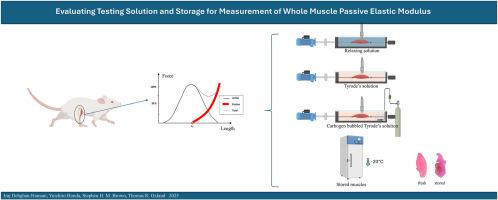Evaluation of testing solution and storage for measuring passive elastic modulus of rat tibialis anterior whole muscle
IF 3.5
2区 医学
Q2 ENGINEERING, BIOMEDICAL
Journal of the Mechanical Behavior of Biomedical Materials
Pub Date : 2025-08-12
DOI:10.1016/j.jmbbm.2025.107162
引用次数: 0
Abstract
Ex-vivo tensile testing is widely used to evaluate the passive mechanical properties of skeletal muscle, particularly the elastic modulus. Researchers commonly use different testing solutions, such as relaxing and carbogen-bubbled Tyrode, and often store small samples in glycerinated solution prior to testing. This paper investigated the effects of testing solutions and storage conditions on the passive elastic modulus of whole muscles in three studies. The objectives were to compare the elastic modulus of whole muscles tested in relaxing solution, Tyrode's solution, and carbogen-bubbled Tyrode's solution (Studies A&B) and to determine whether storage methods can preserve muscles' passive mechanical properties (Study C). Tibialis Anterior muscles (left and right) from 28 male Sprague-Dawley rats were harvested. In Study A, six rats were studied to compare the effect of using relaxing and Tyrode's solutions. Study B involved muscles from eight rats to assess the impact of carbogen aeration in Tyrode's solution. In Study C, 14 rats were used to evaluate the effects of storing muscles in glycerinated solution compared to fresh muscles using three different methods with varying storage durations. The results indicated no significant differences in elastic moduli between relaxing and Tyrode's solutions (p = 0.70) or between carbogen bubbled and non-bubbled Tyrode's solutions (p = 0.81). Also, none of the storage methods preserved the passive elastic modulus of whole muscles compared to fresh muscles, highlighting the need for new storage methodologies if storing whole muscle is required prior to testing. These findings improve the interpretation of passive mechanical property measurements across studies with different conditions.

测量大鼠胫骨前肌全肌被动弹性模量的测试液及储存方法的评价
离体拉伸试验被广泛用于评估骨骼肌的被动力学性能,特别是弹性模量。研究人员通常使用不同的测试溶液,如放松和碳泡Tyrode,并经常在测试前将小样本存放在甘油溶液中。本文通过三个实验研究了测试溶液和储存条件对全肌被动弹性模量的影响。目的是比较松弛溶液、Tyrode’s溶液和碳泡Tyrode’s溶液中测试的整个肌肉的弹性模量(研究A&;B),并确定储存方法是否可以保留肌肉的被动力学性能(研究C)。取28只雄性Sprague-Dawley大鼠胫骨前肌(左、右)。在研究A中,研究了6只大鼠,比较使用放松溶液和Tyrode溶液的效果。研究B涉及8只大鼠的肌肉,以评估Tyrode溶液中碳通气的影响。在研究C中,使用14只大鼠,通过三种不同的储存时间,评估甘油溶液中储存肌肉与新鲜肌肉的效果。结果表明,松弛溶液和Tyrode’s溶液的弹性模量无显著差异(p = 0.70),碳泡溶液和非气泡Tyrode’s溶液的弹性模量无显著差异(p = 0.81)。此外,与新鲜肌肉相比,没有一种储存方法可以保存整个肌肉的被动弹性模量,这突出了如果在测试之前需要储存整个肌肉,则需要新的储存方法。这些发现改进了不同条件下被动力学性能测量的解释。
本文章由计算机程序翻译,如有差异,请以英文原文为准。
求助全文
约1分钟内获得全文
求助全文
来源期刊

Journal of the Mechanical Behavior of Biomedical Materials
工程技术-材料科学:生物材料
CiteScore
7.20
自引率
7.70%
发文量
505
审稿时长
46 days
期刊介绍:
The Journal of the Mechanical Behavior of Biomedical Materials is concerned with the mechanical deformation, damage and failure under applied forces, of biological material (at the tissue, cellular and molecular levels) and of biomaterials, i.e. those materials which are designed to mimic or replace biological materials.
The primary focus of the journal is the synthesis of materials science, biology, and medical and dental science. Reports of fundamental scientific investigations are welcome, as are articles concerned with the practical application of materials in medical devices. Both experimental and theoretical work is of interest; theoretical papers will normally include comparison of predictions with experimental data, though we recognize that this may not always be appropriate. The journal also publishes technical notes concerned with emerging experimental or theoretical techniques, letters to the editor and, by invitation, review articles and papers describing existing techniques for the benefit of an interdisciplinary readership.
 求助内容:
求助内容: 应助结果提醒方式:
应助结果提醒方式:


